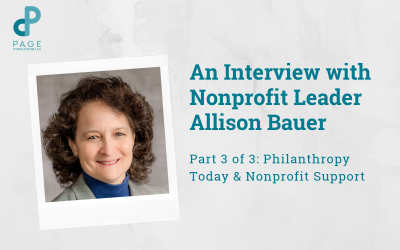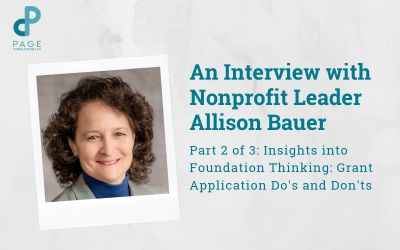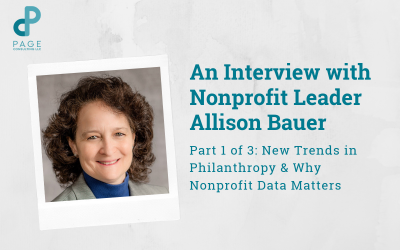To many nonprofits, foundations can seem like mysterious, shrouded institutions. Let us walk you through who these institutions really are and help relieve the twinge of fear and anxiety that accompanies submitting a grant application.
Let’s start by dismantling our practical concerns.
First and foremost: what exactly are foundations?
- Foundations in the U.S. are tax-exempt organizations that are required to spend a minimum of 5% of their assets annually on “charitable purposes.” Those dollars are typically doled out in the form of grants or donations to “qualified” nonprofit organizations, however, that 5% may also include the foundation’s own operational expenses.
- Foundations are not obligated to have a competitive grants process and many actively choose not to do so.
- Foundations come in many different varieties including public, private, family, community, and corporate foundations (not to mention the dreaded donor-advised fund), all of which have their own special quirks!
- Every foundation is required to have a Board of trustees – (the people who make the funding decisions) but many also have professional staff members who help run the organization day-to-day and work directly with grantee organizations.
But understanding what foundations technically are may still not resolve the underlying fear or discomfort we may feel when submitting a grant application to a group of foundation trustees.
- What type of relationship will you be entering into if your grant is awarded?
- What do you “owe” a foundation (if anything) if they make a grant?
- Are you allowed or encouraged to interact with trustees or staff members?
When there is an exchange of money between foundations and nonprofits, there can be real concerns about power and relationship dynamics. This is why it’s important for every nonprofit to know that you are on equal footing with your foundation partners. Here are a few reasons why:
1. Money money MONEY!
Grantmaking is the primary means by which foundations get to keep their tax-exempt status, thereby keeping Uncle Sam out of their pocket. That’s a big deal! Just ask any accountant.
2. A vehicle for foundations to fulfill their missions.
It’s that simple. It is your ideas, your programs, your on-the-ground services, your innovative pilot projects, your relationship with the community that inspire foundations to invest and make a difference. Sure, there are a number of foundations out there that run their own community-based programs, but the great majority of foundations achieve their goals through and because of organizations like yours!
3. Cozying up to your name and brand.
Foundations benefit broadly by “brand affiliation” with nonprofit organizations. Whether it’s a plaque honoring a gift a corporate foundation made to support a new community health center, a press release about a major grant, or just a family foundation trustee bragging about grants they made to local organizations at a cocktail party, foundations get the privilege of tying their name and brand to your work. This boosts the foundation’s standing in the community, may help them attract additional investors (depending on what type of foundation they are), and often gives them special access to your constituents, partners, and events.
I hope this has helped remove some of the mystery around foundations. It’s important to remember that not only is your nonprofit organization helping communities, causes, and people who need it the most, you are also bringing tremendous value to the relationships you have with foundations.
Conversely, it’s important to remember that foundations can offer a great deal to nonprofits beyond funding as well. This includes: publicity, subject area expertise, and potential connections to other donors, public figures, and potential partner organizations that can be real assets to your organization.
When you begin your grant proposals with a solid sense of your organization’s value and all that it brings to a potential partnership, I’m confident that you’ll find the process suddenly becomes a lot less painful and awkward. Building this mindset within yourself (as a grant writer), will influence the narratives you write and the partnerships – yes, partnerships! – you establish with foundations, fostering both success and long-term relationships.
Other tips & Tools
Allison Bauer Discusses Philanthropy Today & Nonprofit Support
In our two recent posts with industry expert, Allison Bauer, we covered philanthropy trends and the power of nonprofit data before diving right into the do’s and don’ts of grant applications. In our final post, we’ve saved the best for last as Allison discusses how we...
Allison Bauer’s Insights into Foundation Thinking: Grant Application Do’s and Don’ts
In our most recent post we sat down with industry expert, Allison Bauer, to discuss emerging trends in philanthropy and the power of nonprofit data. In Part 2 of our interview below, we dive straight into the do’s and don’t’s of grant applications and discuss how you...
Allison Bauer Talks New Trends in Philanthropy & Why Data Matters
This week I sat down with nonprofit leader, academic, and public policy guru, Allison Bauer, to discuss the do’s and don’ts of making your case for foundation support, broader trends in philanthropy, the importance of nonprofit data, and her latest role with the...



